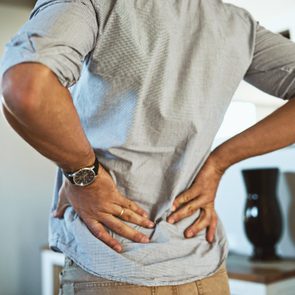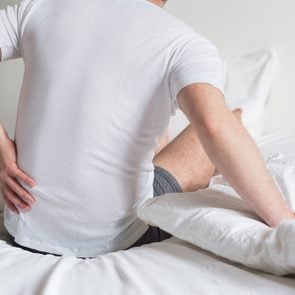5 Stretches for Upper Back Pain
Updated: May 24, 2021
Do these simple expert-approved stretches for upper back pain to help alleviate pent-up tension and increase mobility.
What back pain really means
Back pain is incredibly common. According to the Georgetown University Health Policy Institute, 65 million Americans report recent bouts of pain, with back pain ranking as the sixth most costly health problem in the United States. Sometimes the pain can be so severe that it can be hard to move, think, or even breathe.
“Back pain is common because it’s really a symptom of something else that’s going on,” says Gbolahan Okubadejo, MD, a board-certified spinal and orthopedic surgeon at the Institute for Comprehensive Spine Care in New York and New Jersey. “Our body has a finite number of alarms it can sound to alert us that something’s wrong or that behavior is affecting our spine, so many conditions or bad habits have back pain as an overlapping symptom,” Dr. Okubadejo explains. And when you don’t know the direct cause of your pain, it can make it harder to treat it.
Getting to the root of your back pain
Your lifestyle can play a major role when it comes to the frequency and severity of back pain. Sitting or standing with poor posture, failing to move around or get enough exercise, or performing work tasks without paying attention to proper ergonomics can all play a role in upper back pain or discomfort. A quarter of all people who have back pain are in poor physical condition.
“This is important to note because if you have a weakened core or imbalances in the body, your muscles try and compensate for even the smallest task. But the brunt of that compensation usually happens in the back, leading to pain,” Dr. Okubadejo says.
(Try these back exercises you can do at home to get stronger and prevent injury.)
Technology
And it’s not just general inactivity that is wreaking havoc, but technology also plays a part.
“Your head weighs about as much as a bowling ball when you’re sitting up straight,” says Lalitha McSorley, a physiotherapist and founder of Brentwood Physiotherapy in Calgary, Canada. “If you lean 15-degrees forward, your muscles have to work three times as hard, as your head now exerts 27 pounds of downward force,” she says.
A poor head position puts pressure on your muscles, like your upper cervical extensors (involved in extending the neck), which could result in damage, McSorley explains.
And leaning your head forward to stare at your phone is a prime example of “tech neck,” where technology-related bad posture can directly lead to symptoms of back pain.
(Here’s how to improve your posture for back pain relief.)
Chronic stress
McSorley also emphasizes that chronic stress can eventually cause upper back pain because when your body is under stress, you tend to tighten up, even if it’s a subconscious response. “Breathing patterns change, shoulders hunch, and muscles tense. Over a short period of time, this won’t do any damage; however, if left untreated, you can start developing pain in the mid-back,” she says.
(Here are some of the surprising reasons for back pain.)
Stretching to ease the pain
There are basic stretches that can help ease pent-up tension and increase mobility through your scapula, shoulders, neck, and spine. This is particularly true if you work a desk job and find your pain increases the longer you sit still. Make sure you take breaks to “shake it out” and loosen up your tight spots. Even just standing up, walking around, rolling your shoulders, and rotating your neck pack and forth a few times could make you feel better.
However, you should only do these stretches if your upper back pain isn’t linked to an injury and isn’t causing symptoms, like numbness or tingling in your extremities, problems with vision, or severe limitations in movement. If you’re experiencing any of these symptoms, you should contact your doctor immediately. (These are the signs your back pain might be an emergency.)
Stretches for upper back pain to do at work
These stretches for upper back pain can be done during your workday whether you’re at home or in the office. (Also, try these exercises for lower back pain.)
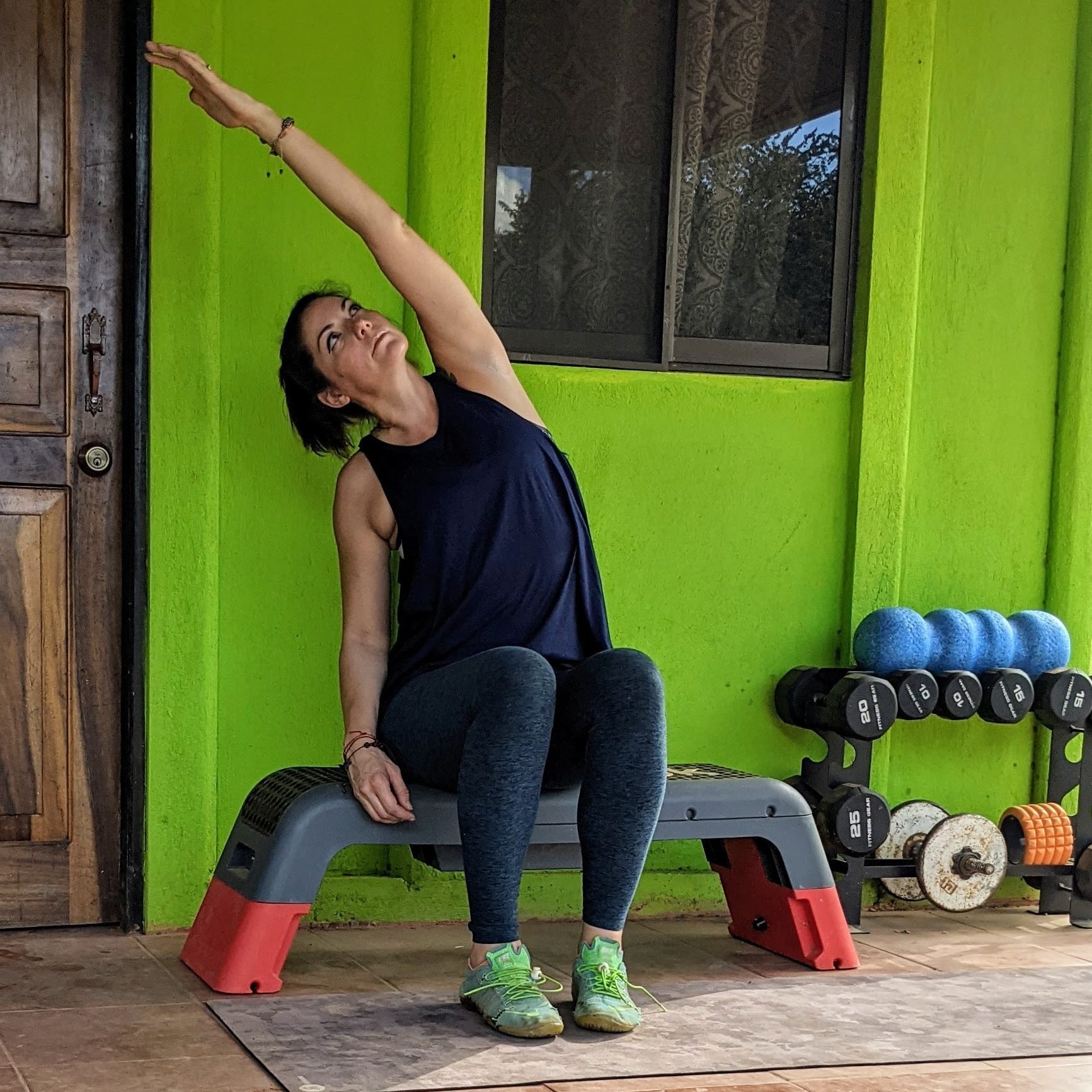
Overhead arm reaches
Sit tall on a bench or chair, your shoulders back, chest lifted, with good posture so your ears are aligned with your shoulders and hips. Lift your left arm directly overhead, your palm facing inward. Take a deep breath in, and as you exhale, reach your left arm across your body toward your right side as you lean slightly to the right, feeling a stretch in your upper left back and side.
Turn your head slightly to the left to look up toward your extended hand. Hold for a full deep inhale and exhale, then on your next inhale, return to the starting position. Repeat for a total of 30 seconds before switching sides.
(Try these easy moves to get stronger arms.)
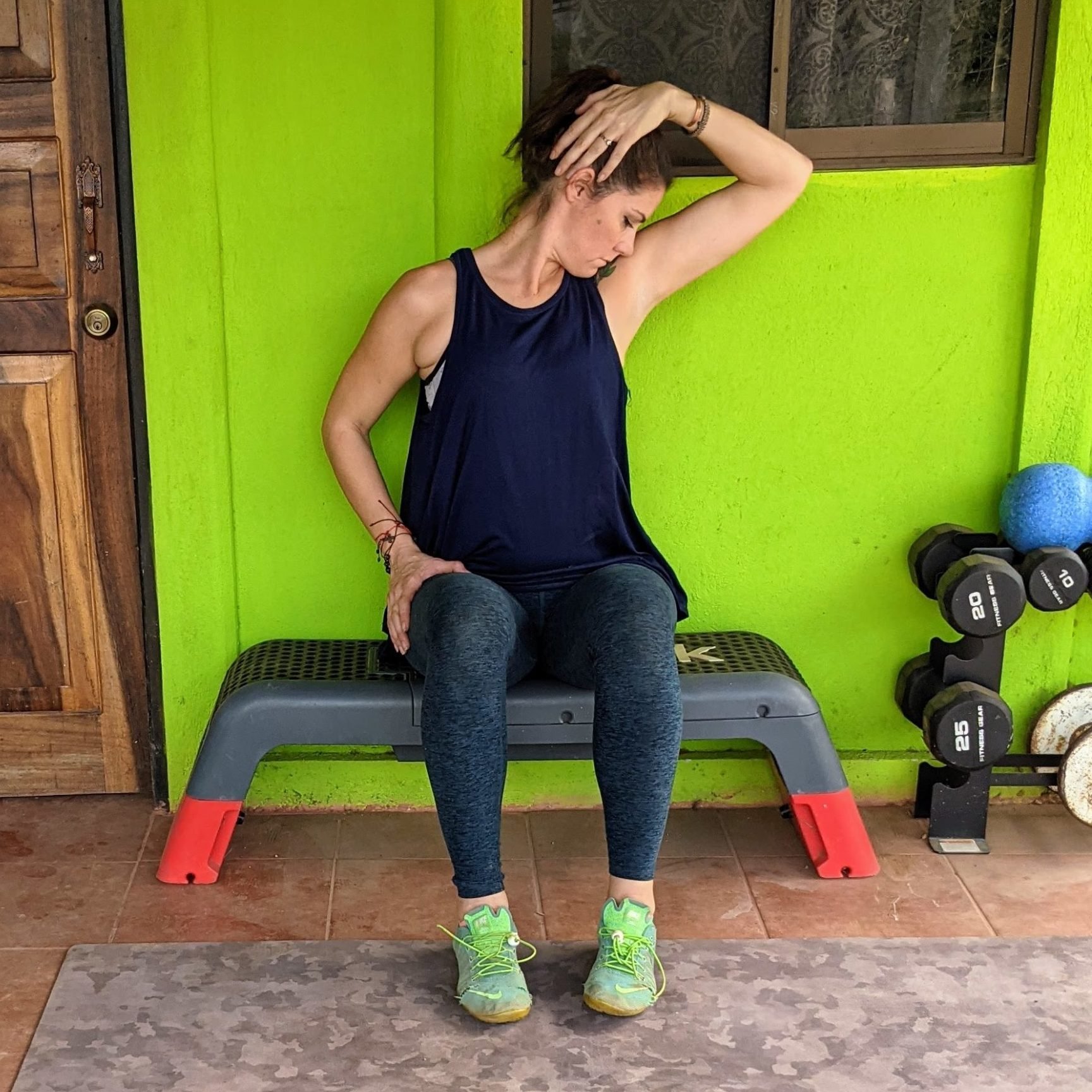
Nose to armpit
This simple stretch can help loosen up your trapezoids, which often become tight while sitting at a desk all day.
Sit tall on your chair or bench with good posture. Reach your left arm directly overhead, your palm facing inward, then bend your elbow, placing your left palm on your right ear.
Take a deep breath in, then on your exhale, use your left hand to slowly and carefully guide your nose toward your left armpit as you turn your head and look down. Stop when you feel a good stretch on the right side of your neck and upper back. Hold for a full inhale and exhale, then on your next inhale, return to the starting position.
Repeat for a total of 30 seconds before switching sides.
(Improve your posture with these expert-recommended posture correctors.)
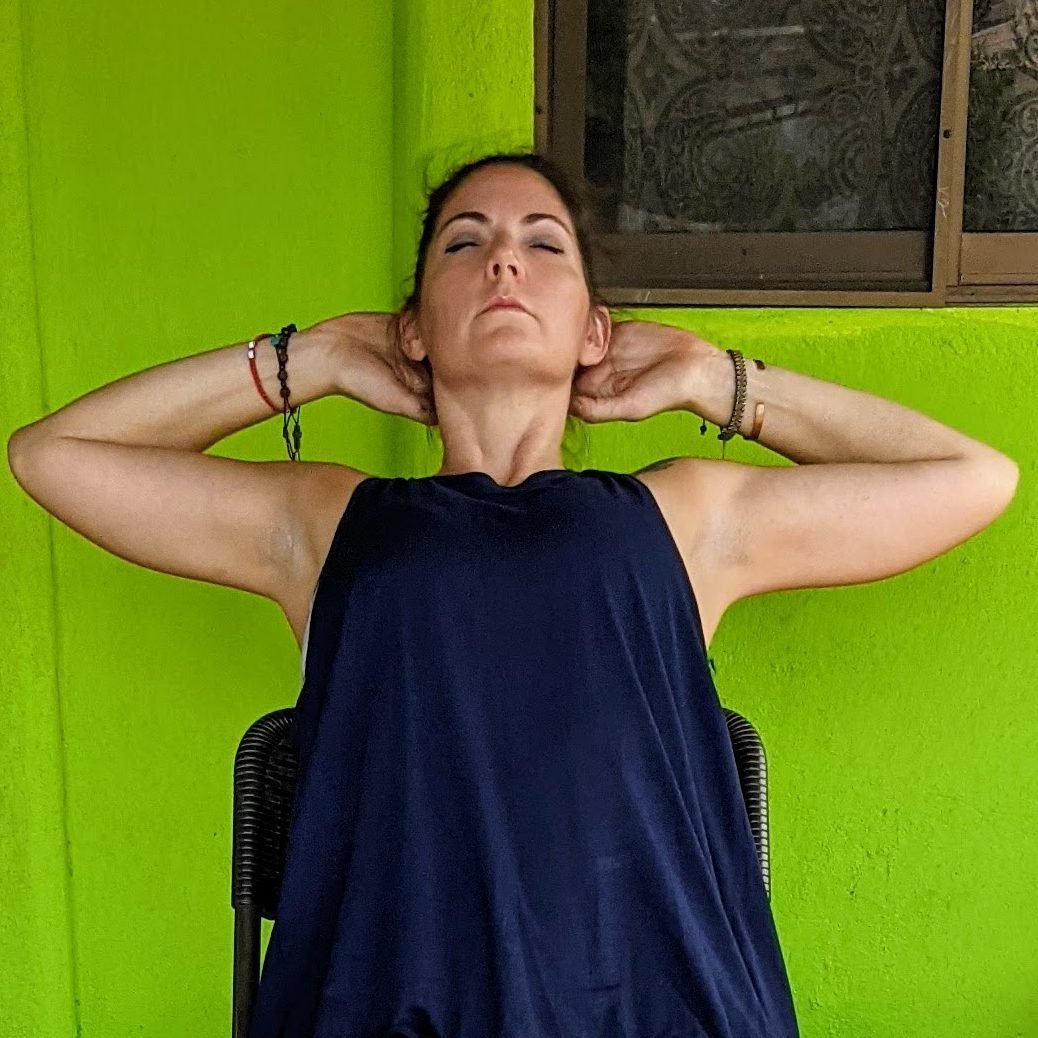
Chair chest opener
This simple chest opener provides a back extension that may help alleviate discomfort. This is especially true if you’re constantly sitting with your shoulders rolled forward and your neck hunched.
Sit tall in a chair that has a back, so your knees and hips are bent at 90-degrees. Scoot your hips to the back of the chair so you can use the back support for the stretch. Place both hands to the outside of your ears, lightly supporting your head, with your elbows pointing outward.
Take a deep breath in, and as you exhale, look up and press your chest forward as you lean back into the chair and open your elbows wide. You should feel a stretch across the front of your chest and shoulders as your back and neck move into extension. Pause for a full inhale and exhale, then on your next inhale, return to the starting position.
Repeat for a total of 30 seconds.
(Got low back pain? Try these stretches for lower back pain.)
Stretches for upper back pain to do after a workout
Adding upper back stretches as part of a regular exercise routine can help restore mobility and correct muscular imbalances. For example, after a cardio or strength training routine, try adding five to 10 minutes of stretching that takes your muscles through a full range of motion. (Should you stretch before a workout?)
Here are a few stretches to help you get started.
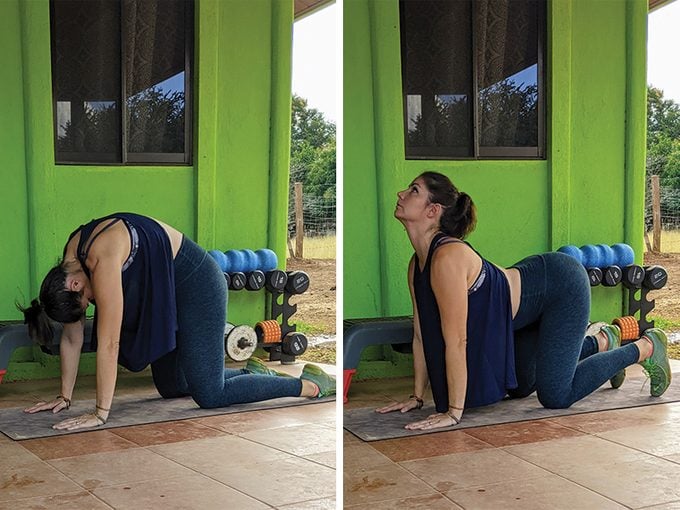
Cat-cow
Cat-cow is an excellent stretch for all types of back pain because it takes your spine through full flexion and extension. This can help loosen tight muscles and restore areas of limited mobility.
Start on your hands and knees on the ground in a “tabletop” position with your knees under your hips, your palms under your shoulders, your neck and back in a straight and “neutral” position. On an inhale, look up and lift your chest forward as you allow your belly to drop toward the floor and you press your tailbone up toward the ceiling. This will create a “U” in your spine from your tailbone to the crown of your head. Try to fully extend each of your vertebrae as much as you can.
On an exhale, reverse the movement, drawing your pelvis toward the mat as you round through your spine, pressing your mid- and upper-back toward the ceiling. Do this as you lower your head between your arms, creating an arch with your back.
Continue slowly alternating between “cow” on each inhale and “cat” on each exhale for 30 to 60 seconds.
(Beware of the everyday habits that are damaging your spine.)
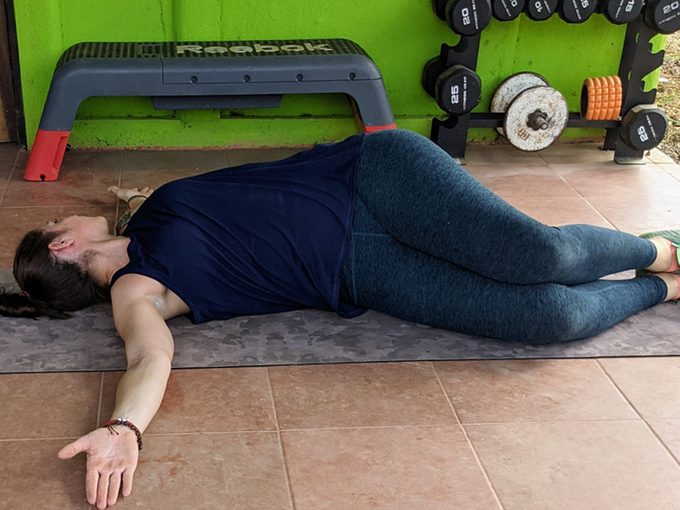
Open books
Open books can help “open up” your chest and shoulders while also offering a simple spinal twist at your mid- to upper-back.
Lie on your right side on a mat with your knees and hips bent at 90-degrees, your left leg stacked on top of your right leg. Reach your arms directly in front of your chest and allow your head and neck to relax. (You may want to use a pillow or block to support your neck.) Take a deep breath in, and as you exhale, arc your left arm straight up then behind your body as you rotate your left shoulder, then your spine and neck, to accommodate the movement.
Continue the arc with your left hand until your chest and shoulder are fully “open,” your left arm reaching as far back as you comfortably can. Hold for three deep breaths, then on your final exhale, return to the starting position. Repeat for a total of 30 to 60 seconds before switching sides.
Next, check out the best back massagers for lower back pain relief.



















